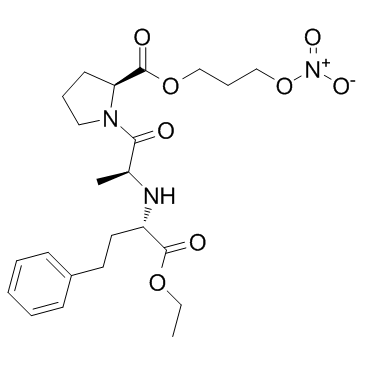690655-41-5
| Name | NCX899 |
|---|---|
| Synonyms |
L-Proline, N-[(1S)-1-(ethoxycarbonyl)-3-phenylpropyl]-L-alanyl-, 3-(nitrooxy)propyl ester
3-(Nitrooxy)propyl N-[(2S)-1-ethoxy-1-oxo-4-phenyl-2-butanyl]-L-alanyl-L-prolinate |
| Description | NCX899 is a NO-releasing derivative of enalapril, and shows inhibitory activity against angiotensin-converting enzyme (ACE) activity. |
|---|---|
| Related Catalog | |
| In Vivo | NCX 899 (NCX, 25 mg/kg, n=10) decreases the end-diastolic dimension in cardiomyopathic (CM) with heart failure. NCX 899 inhibits ACE activity and increases the plasma nitrate levels in CM hamster[1]. NCX899 (4 micromol/kg, i.v.) inhibits the activity of serum angiotensin-converting enzyme in dogs. NCX899 significantly attenuates both arterial hypertension and bradycardia[2]. |
| Animal Admin | Enalapril (40 nmol/kg per min), NCX899 (35 nmol/kg per min) or sterile saline are infused at a flow rate of 0.5 mL/min over 15 min. Next, cumulative doses of NG-nitro-l-arginine methyl ester (l-NAME; 0.1-10 mg/kg) are injected during infusion of enalapril, NCX899 or saline infusion. The l-NAME is infused at a rate of 0.5 mL/min over 15 min for each dose. At the end of each infusion, the resulting haemodynamic changes are recorded. The total dose administered of NCX899 and enalapril throughout the protocols is 3.5 and 4.0 µmol/kg, respectively. The haemodynamic variables are measured before and after each l-NAME dose in all groups. The MABP and HR are displayed continuously on a computer monitor and are recorded on a printer coupled to this system. Measurements of the haemodynamic events are performed in triplicate for each time period. |
| References |
| Density | 1.2±0.1 g/cm3 |
|---|---|
| Boiling Point | 622.7±55.0 °C at 760 mmHg |
| Molecular Formula | C23H33N3O8 |
| Molecular Weight | 479.523 |
| Flash Point | 330.4±31.5 °C |
| Exact Mass | 479.226776 |
| LogP | 3.80 |
| Vapour Pressure | 0.0±1.8 mmHg at 25°C |
| Index of Refraction | 1.535 |
| Storage condition | 2-8℃ |
